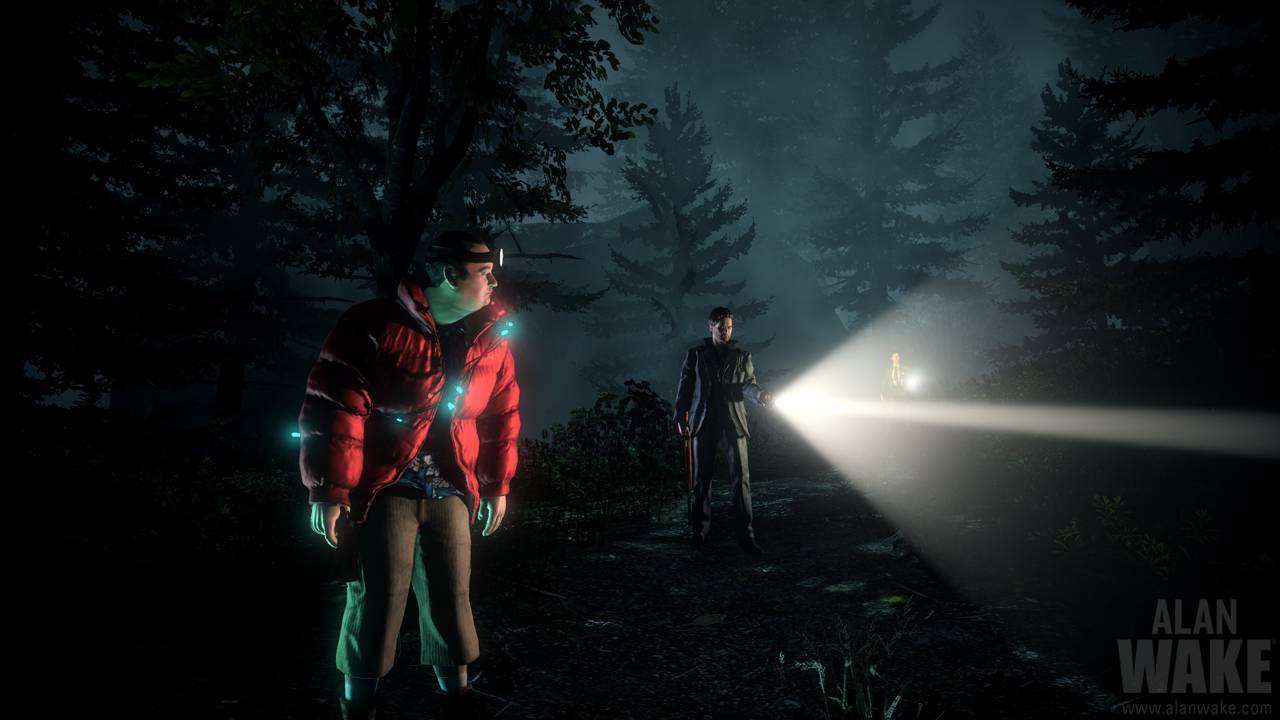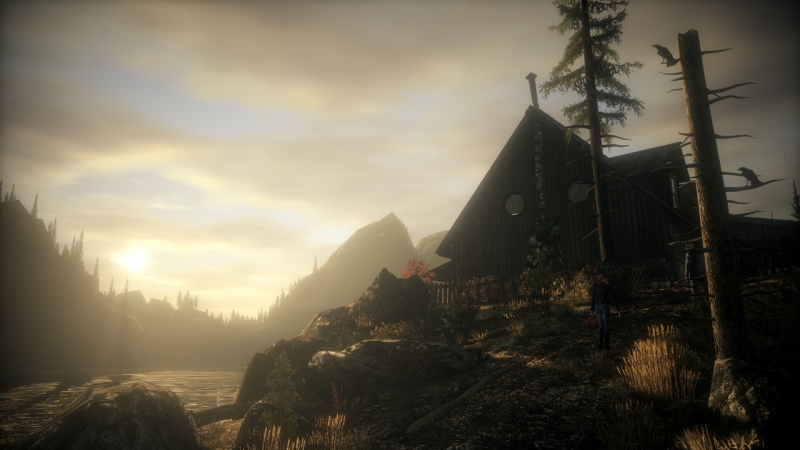A good game is like a cooked meal: You don’t want to eat it cold but if left in the oven for too long it’s going to crash and burn. Just look at 2008’s terrible action RPG Too Human: Ten years in development and very little to show for it. Alan Wake might not have had quite as extreme a delay in its development cycle but it has been in the works at Remedy studios for five years, but thankfully in this case the hard work has paid off. Alan Wake is by no means perfect but it enriches the horror genre in a unique way and is a necessary purchase for any survival horror aficionados.
The game is named after our protagonist, a successful horror writer who after suffering from writers block, goes to the town of Bright Falls with his wife Alice in the hope of clearing his head and getting some R and R. Soon after arriving Alice is kidnapped and dark forces begin taking over the town and it’s up to Wake to stop them. Rubbish holiday aside, it’s easy to see that Alan Wake wears its influences on its sleeve as it forms its story. The constant Stephen King style narratives and the clear similarities between the town of Bright Falls and David Lynch’s Twin Peaks initially rubbed me the wrong way, but the style begins to grow on you and by the end of the game you will see Alan Wake as it was clearly intended: A loving homage to classic horror novels, films and TV shows.
The TV thriller style is mimicked by the presentation of the story as the game is split into six episodes, complete with ending credit music (but no credits oddly enough) and a previously on Alan Wake summary at the beginning of each new chapter. This keeps the game flowing well and helps retain the pace as the story advances, but unfortunately the plot suffers from the same pitfalls as a lot of TV shows as the start of the game features a lot of exposition that the player almost has to wade through before the fun begins. Once the tale hits its full stride it becomes a roller-coaster ride with enough twists and turns to keep you guessing, even if the conclusion is a little on the unusual side. It’s a great storyline through and through but it’s a shame it doesn’t manage to hit the ground running.
The characters too succeed at keeping the player gripped and involved in the game. The residents of Bright Falls are weird and wonderful and help add to the bizarre nature of the experience. Our intrepid hero is also well realised and is troubled enough that you would struggle to not identify with him on some level. For those of you familiar with Remedy’s previous Max Payne titles, you will know that they have a knack for creating deep and three dimensional protagonists. The relationship between Wake and his wife is also convincing and does a good job of motivating the player, which is obviously important considering it provides the main backbone of the story.
Whilst mainly focusing on horror, suspense and story-telling, Alan Wake binds all its elements together through a robust and sturdy third person shooter engine. So far so generic, but Remedy sets the combat apart from it’s competitors through the use of light. The enemies in Alan Wake are all weak to light so you have to factor this in to any skirmishes you find yourself involved in. For those of you who were fortunate to have played either Obscure or the fourth Alone in the Dark title you will know when I’m coming from, but the use of light goes above and beyond the call of duty in Alan Wake. Torch batteries need to be stocked, Generators kept running, searchlights re-appropriated and, of course, flare guns loaded. The guns found throughout the adventure are pretty standard shooter fare ranging from pistols to shotguns and rifles, but it’s the light-based weapons that really shine. The usually ignored flares and flash bangs of other shooters take on a new significance in the universe of Alan Wake, and their extreme room-clearing properties will constantly keep you on the lookout.
You will not find yourself searching for just weapons to use throughout the game. Remedy paints an intriguing world and wants you to explore every inch of it by giving you various collectibles to root out. Unfortunately these are a mixed bag. Some of the collectibles really expand on the games main story such as the manuscript pages that cryptically tell of the games events from various perspectives and the radio shows that further delve into the strange goings on in Bright Falls. Various TV sets can be found during the adventure that run a twilight zone style thriller
show, that is strangely captivating and is a very endearing pastiche of old school horror films and TV shows. Yet on the other side of the coin are the random Coffee Thermoses that need collecting and coke can pyramids that need toppling over. It’s not like they detract from the game or anything, but considering the creativity put into the other collectibles, these ones seem pointless and a bit out of place. All the collectibles are quite sensibly placed and don’t suffer from the usual pitfall of being almost impossible to completely track down without a guide.
The game isn’t open world in any sense of the word but the levels feel very open ended and non-linear. The player is constantly kept informed of their next objective by a dot on a compass in the top left corner of the HUD to ensure they wont lose their way. Whilst this keeps the action moving forward at all times it might have been helpful if a mini map had been included to make navigation easier. The levels are quite well designed so getting lost isn’t ever much of a problem even if there is no map screen to speak of. The set pieces and climax moments in the game are fantastic and add a welcome variety to the mission structure ranging from defending various allies and places of note, to the occasional “whoops I’ve lost all my weapons and need to run away” moments. It’s unfortunate then that the game suffers from a few repetitive environments. It’s only applicable to one section in episode two but it does get a bit frustrating seeing nothing but rural pine forests for such a prolonged period of time.
Despite an over-used forest section the graphics throughout are incredible and help bring the story to life. As should be expected from a game that places such a strong emphasis on the forces of light and darkness, the lighting engine in Alan Wake is excellent and really adds to the atmosphere the game so successfully creates. The attention to detail in the visuals is also noteworthy. There are signs in the background, birds in the trees and moths flicker around varying sources of light. This sadly stretches to some rather frustrating product placement. Yes, I saw that the torch said Energizer on it, so was it really necessary to name an achievement after energizer batteries as well? These minor niggles aside it’s hard to argue that the visuals are anything but effective and beneficial to the immersion of the player.
The sound also helps to keep the suspension of disbelief going through some fantastic voice acting and appropriate in-game music. The in-game tracks always suit the mood but they’re a little generic and aren’t especially memorable. A lot of the soundtrack music is licensed from real songs however, which further increases the realism of the story and will also put a few smiles on your face along the way. Gotta love that jukebox. Another success in the realm of audio comes through the beefy sound effects. The guns sound powerful and help make the combat feel more intense and satisfying, and don’t get me started on the sounds of the flash bang and flare gun. They might not be what you’re expecting but I mean this in a very positive sense. They are awesome to behold.
Alan Wake does a lot of things well with only a few blemishes. Sadly all good things must come to an end, but depending on how much time you spend exploring you may feel it comes to an end a little too soon. I wouldn’t say it’s too short as it feels right being the length it is and the story doesn’t abruptly end or anything, but sadly with no multi-player or other modes of play some players may feel like there money hasn’t gotten them much. All things said it’s still a good eight hours or more for a single play-through and the inclusion of difficulty specific collectibles will warrant a second run-through for the completionists out there. Those of you who do want to explore every nook and cranny will enjoy the achievements on offer in Alan Wake as many of them are based on getting all of each type of collectible. As frustrating as I found these particular ‘chievies the others are for varying combat feats and story progression and feel well balanced and were fun to track down. Hopefully the new DLC that’s coming this summer will help further justify the price tag, especially as it’s free for those of you who buy the game new.
Alan Wake is a lot like the horror novels it so oft references. It’s short and sweet at the same time as being entirely memorable and chilling while it lasts. The shooting aspects are robust but take note that if you are expecting something along the lines of Quake then you will be disappointed by the action on offer. If however, you want an intelligent and gripping story set in a fantastical world then you’ve come to the right place. It’s nice to see a new title jump into the horror game scene that isn’t a Resident Evil or Silent Hill game, and it’s even nicer that Alan Wake is able to hold it’s own against the big boys. Remedy knew their target audience for Alan Wake and if you think you might be a part of that demographic then I strongly recommend you pick up a copy the next chance you get.
This game was reviewed on the Xbox 360.
Gripping story, Fun use of light as a weapon, Atmospheric visuals
A little on the short side, A slow start that might put some players off




















